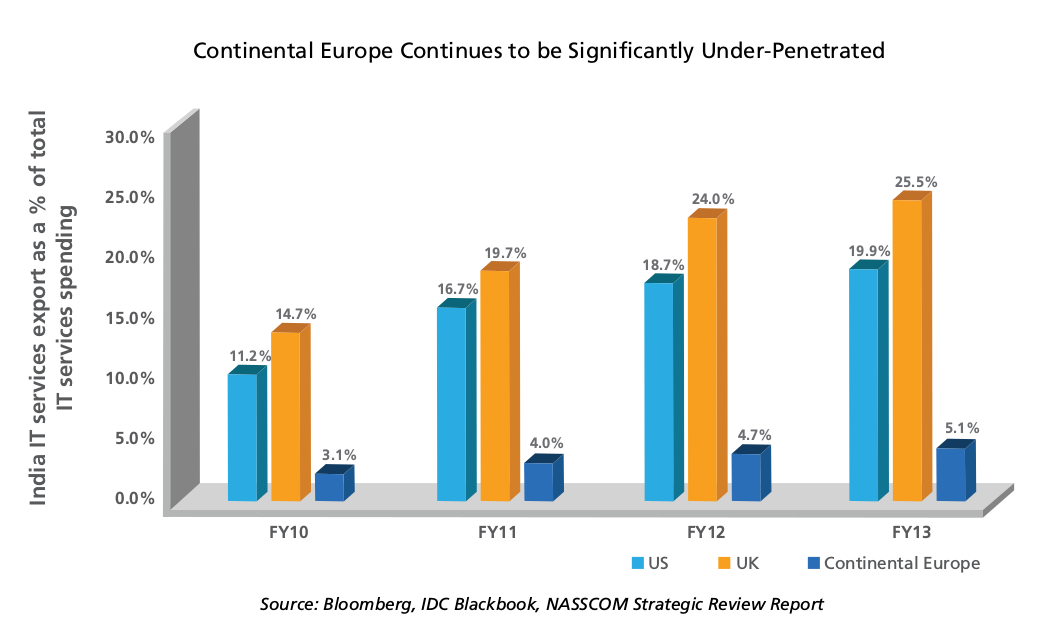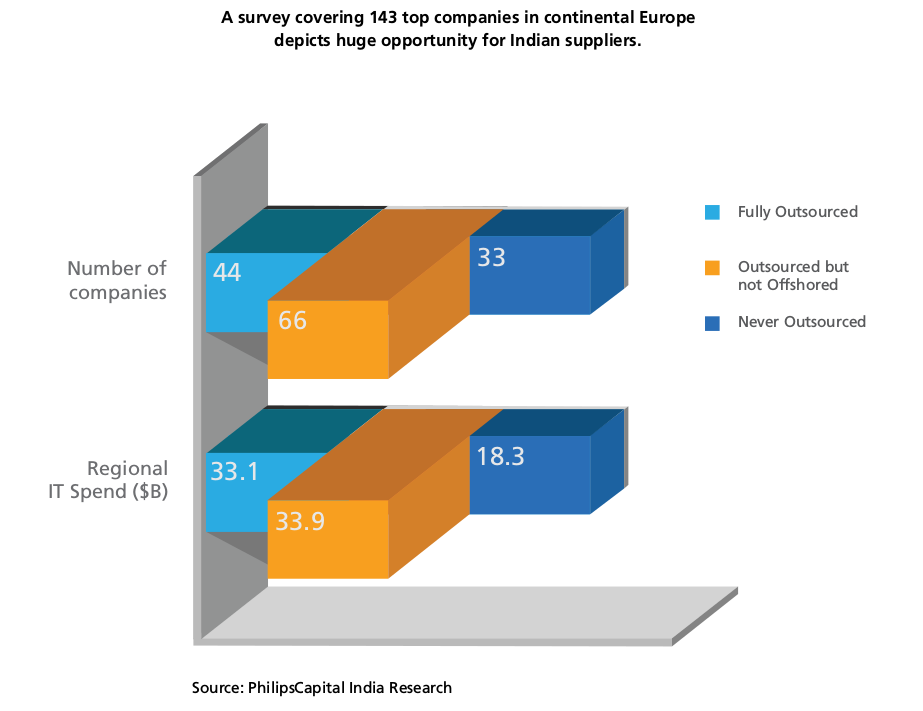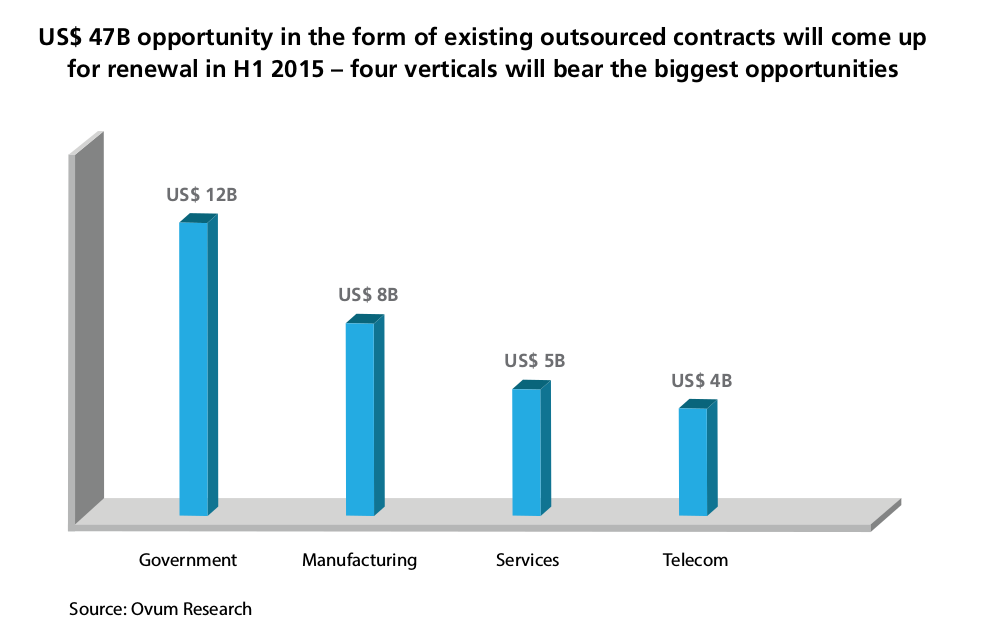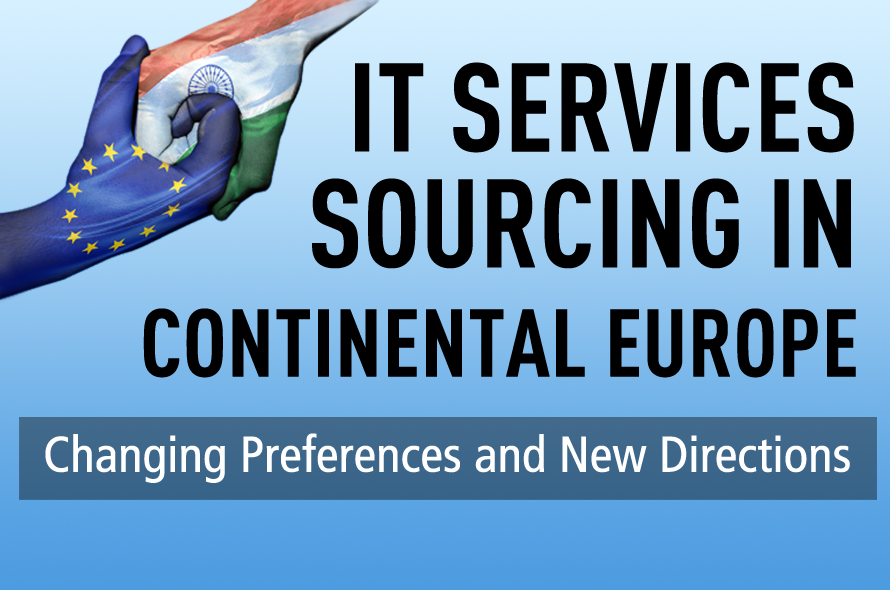The IT services supplier landscape in continental Europe has experienced a dramatic turnaround in supplier preference in the last few years. Continental Europe, which had been extremely reluctant to outsource IT operations of its resident companies, has started to open up to the idea of outsourcing. The fact that the European IT market is as large (in size) as that of North America and yet remains largely untapped, has caused a gold rush among the Indian IT service suppliers who have been facing the competitive pinch in a largely saturated North American IT services market.
Indian IT services companies have possibly benefitted the most from the opening up of the European IT services space. Indian IT service suppliers – such as TCS, Infosys, Wipro, HCL Technologies, Tech Mahindra, and the tier-two Indian IT services suppliers, such as L&T Infotech, NIIT Technologies and Mindtree – have become known entities in the IT services market in continental Europe. The well-planned and persistent efforts of Indian suppliers to penetrate the European market and the turnaround in socio-economic factors need to be credited for the paradigm shift in IT services supplier sourcing preference.

Background
Continental Europe, during the first decade of 2000s, proved to be an extremely difficult terrain to conquer for the Indian IT services suppliers. The challenges faced by the Indian IT services suppliers can mainly be grouped in three categories:
- Legacy European IT service suppliers dominating the mindshare of key IT decision makers
- Reluctance toward offshoring due to cultural and mindset barriers
- Lack of onshore and/or nearshore development centers in continental Europe, raising questions on the commitment of the Indian suppliers to their European clientele
While Indian IT services suppliers can hardly be held accountable for the culture and mindset issues impeding their entry into Continental Europe, their approach toward the market has been lackluster and without any strategic focus, in general. For the major part of the last decade, Indian suppliers remained reluctant towards establishing on-shore and/or near-shore delivery capabilities and were content having a few sales offices across locations in continental Europe. This approach was a deal breaker for prospects who sought consulting and IT delivery capabilities in sync with the local markets and business environments. The Indian IT services suppliers appeared content with their North American operations and lacked motivation toward putting together a well-knit strategy of expanding into the European marketplace.
What Prompted the Changed Sourcing Preference?
The economic downturn in Europe in late 2000s caused a paradigm shift in the manner in which the companies in continental Europe approached IT outsourcing. Faced with rising cost pressures, regulatory challenges and a declining demand environment, many European enterprises started seeking newer avenues of cutting costs without compromising much on quality. This placed outsourcing on the table.
Also, a slowdown in profitability and growth in the U.S. markets due to high penetration, intense competitive rivalry and key immigration reforms forced the Indian IT services suppliers to contemplate expansion into greener pastures. The overlap of these trends meant that the Indian IT services suppliers were at a tipping point which had implications for the entire IT business landscape in Europe.
Driven by these new market dynamics, Continental Europe, finally shunned the mindset barriers and challenges posed by local labor laws to open themselves up to the offshore global delivery model which was already an established and widely accepted sourcing practice in the U.S. and U.K.
Current Situation
While the tipping point for the continental European businesses to shed their inhibitions towards Indian IT service suppliers arrived in the latter half of the first decade of 2000, it took a further three years for businesses and analysts to realize the dramatically changed IT services sourcing preference in the region. While the initial breakthroughs made by Indian IT services companies were dismissed as mere aberration, the consistent growth of these offshore companies over a period of three years meant that the continental European IT services sourcing preferences had surely experienced disruption.
The following key trends indicate that the growth momentum of Indian IT service suppliers in continental Europe will only intensify in the coming days:
- Continental Europe has gradually started developing an appetite for offshore IT outsourcing suppliers. The blue-ocean opportunity that the landscape presents is too large to be overlooked. And with Indian IT services suppliers building credibility among the prospect base in continental Europe, we see increasing instances of IT services deals being captured by the Indian suppliers.
- Indian IT services suppliers have changed their approach of targeting the different continental European geographies as one homogeneous region (as they did with North America), and are targeting each country in the region as a separate geography.
- The firms have also pursued strategic inorganic growth options through timely and cogent acquisitions of specialist European IT services and consulting firms.
- Tier-one and Tier-two Indian IT services suppliers have increased investments in service line expansions and have intensified effort and investment toward building visibility with sourcing advisory firms.
- Indian suppliers have also tried shifting away from the traditional approach of promising cost savings through a labor arbitrage model and are pitching for new client deals on a value-based differentiation parameter.
- Suppliers have been able to structure their approach around a global delivery model with a suitable mix of offshore, onshore and nearshore options.
- Pipeline growth in excess of 50 percent Y-o-Y, and contract win rates of 50 percent from tier-one Indian IT services firms in 2013-14, indicates the highly improved performances of the Indian suppliers.
The points mentioned above have led to a highly improved situation for the tier-one Indian IT services suppliers who have reported double digit revenue growth Y-o-Y in 2013-14. Indian suppliers have also been able to counter challenges posed by stringent labor laws in the region by having the flexibility to accommodate manageable clauses. We clearly notice these firms continuing to gain traction with Continental European clients due to their ability to deliver quality services at extremely competitive prices by leveraging low-cost labor through offshore and nearshore delivery centers and client-centric global delivery models.

Growth Strategy of Indian IT Services Firms in Continental Europe
Indian IT services supplier have taken a number of strategic initiatives to pursue growth in continental Europe. Some of the more prominent measures include:
- Pursue Inorganic Growth: Indian IT firms leveraged the opportunity that the economic downturn of 2009-10 in Europe presented and made strategic acquisitions (of local and regional companies) to enhance their competitiveness in continental Europe. Infosys’ acquisition of Lodestone, TCS’ acquisition of Alti and Cognizant’s acquisition of Equinox Consulting are examples in this regard. Indian IT services suppliers also leveraged their strategic global partnerships with the likes of SAP, Oracle and Microsoft in their solutioning and go-to-market exercises in Continental Europe
-
Penetrate and Radiate: Macro trends – IT outsourcing deals getting smaller in sizes, deals being split between service suppliers, and contract renewals changing hands between service suppliers more frequently – in continental Europe have augured well for Indian IT services suppliers looking to duplicate the “penetrate and radiate” strategy that they have successfully executed in the U.S. and U.K.
The approach of signing clients up for small engagements or single service line deals, proving their delivery capabilities on the smaller engagements and focusing on process and quality at attractive price points helped the Indian firms strengthen their client relationships. This helped yield trust and confidence that led the clients to expand spending with Indian IT services firms across service lines. Almost all the Indian IT services suppliers have selectively deployed the “penetrate and radiate” strategy to gain foothold in new accounts.
-
Pursue Localization: Communication and mindset barriers were the biggest challenges that Indian IT service suppliers were unable to scale in their earlier efforts to build a presence in Continental European. Localization helped the Indian companies to address the cultural and language-specific challenges posed by different countries in the region. Indian IT services firms, through their inorganic acquisitions, were able to put together a team which had a deep-rooted understanding of clients in Continental Europe.
Setting up dedicated client delivery centers in continental Europe and hiring senior executives with experience of managing European client accounts were further proof of the localization commitment of Indian IT services firms. For example, TCS, Infosys, HCL Technologies and Wipro set up dedicated client centers comprising 20 to 1,000 dedicated FTEs across client locations in France, Germany, Finland and Sweden. In addition, having specific GTM, sales and pursuit teams with local management for countries within continental Europe has been the way forward for the Indian IT services firms.
- Ramp Up Nearshoring Capabilities: Indian IT service suppliers have strategically located their nearshore development centers in the low-cost locations of Eastern Europe to address the needs of time zone proximity and language compatibility. Poland, Romania and Hungary have been the most sought-after nearshoring destinations. Cognizant has focused on Budapest in Hungary, Valladolid in Spain and Gdansk in Poland as its low-cost nearshoring destinations, while HCL Technologies has set up its delivery center in Poland and Ireland. Wipro has multiple nearshore delivery centers based out of Poland, Romania and Hungary, whereas Infosys has its nearshore delivery center in Poland that also doubles up as an SAP competency center.
How is the European IT Services Sourcing Landscape Expected to Evolve Amid Changing Preferences?
The aggressive growth of Indian IT services suppliers in continental Europe has disrupted the established business models of legacy European IT services firms, and is expected to further erode supplier power in the coming years.

While the climax in this intense duel between onshore and offshore IT services suppliers is difficult to predict, GEP sees a different set of approaches being adopted by Indian suppliers and legacy European suppliers in their attempt to come up trumps:
Indian IT Services Suppliers Will:
- Continue to invest in localization, dedicated country teams and senior leadership, and dedicated onshore and/ or nearshore client delivery centers which helps the Indian suppliers manage compliance and security-related concerns of clients
- Seek inorganic growth opportunities through acquiring regional and/or local firms that fit well with their future strategy for growth
- Focus on driving industry focused cloud, mobility, analytics and digital business-enablement solutions which have emerged as key differentiation parameters in an otherwise commoditized supply landscape
Legacy European IT Services Suppliers Will:
- Proactively prepare a competitive response to the Indian IT services suppliers surge in continental Europe through a cost-competitive global delivery model
- Tend to focus on industrialization and automation opportunities to complement a global delivery model
- Boost the disruptive technology portfolio, especially focusing on SMAC (social, mobility, analytics and cloud computing)
And, amid this intense battle between the Indian IT services suppliers and their European counterparts, the IT services procurement teams at the end-user industries can emerge as the real winner.

